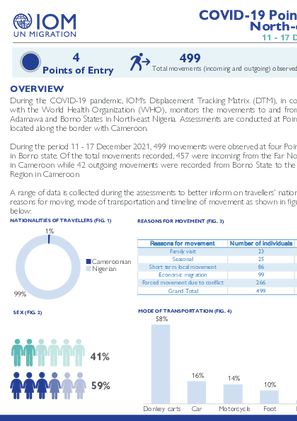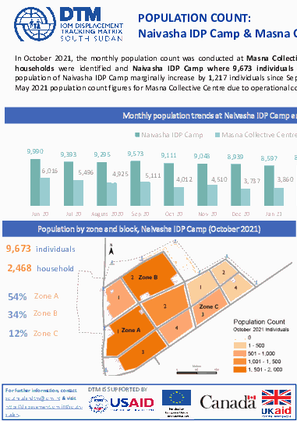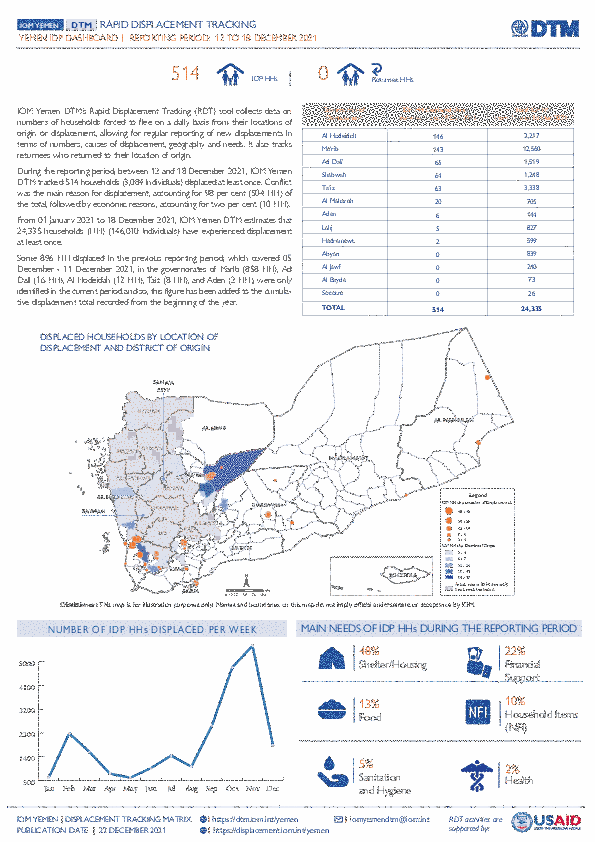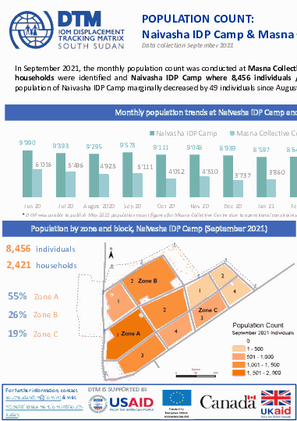-
Countries
-
Data and Analysis
-
Special Focus
-
Crisis Responses

Contact
DTM Sudan; dtmsudan@iom.int
Language
English
Location
Sudan
Snapshot Date
Dec 19 2021
Activity
- Event Tracking
- Mobility Tracking
The DTM Emergency Event Tracking (EET) is deployed to track sudden displacement and population movements, provide more frequent updates on the scale of displacement, and quantify the affected population when needed. As a subcomponent of the new Mobility Tracking methodology in Sudan (Round Two), and activated on a need basis, EET utilises a broad network of key informants to capture best estimates of the affected population presence per location – a useful tool for humanitarian response planning and design.

Contact
DTM Mauritania, DTMMauritania@iom.int
Language
French
Location
Mauritania
Period Covered
Mar 26 2021
Apr 08 2021
Activity
- Survey
- Flow Monitoring Survey
- Migrants presence
La ville de Nouakchott, capitale politique de la Mauritanie, concentre également une part importante de l’économie du pays et constitue une destination privilégiée des travailleurs migrants à la recherche d’emploi, notamment ceux en provenance des pays d’Afrique subsaharienne. Par ailleurs, la position géographique de la Mauritanie, situé entre l’Afrique subsaharienne et la partie nord du continent, favorise la dynamique migratoire autour de la Mauritanie. La Mauritanie, et surtout sa capitale Nouakchott, est devenue, ces dernières années, un point de transit pour les migrants se dirigeant vers l’Afrique du Nord ou l’Europe. Pourtant, peu d’informations sont disponibles concernant la migration à destination et transitant par Nouakchott. Une meilleure appréciation du stock migratoire à Nouakchott, des profils et besoins des migrants permettrait de mieux concevoir des programmes et politiques visant à gérer les migrations et à l’appui à cette population dans la capitale.
C’est dans ce cadre que s’inscrit la présente enquête réalisée à Nouakchott et à Nouadhibou conjointement par l’Agence Nationale de la Statistique et de l’Analyse Démographique et Économique (ANSADE) et l’Organisation Internationale pour les Migrations (OIM), au travers le Système de Suivi des populations mobiles (Displacement Tracking Matrix, DTM en anglais). Le but de cette étude est de cartographier les zones à forte présence migratoire et dresser les différents profils des populations migrantes dans la ville afin d’obtenir une meilleure compréhension du phénomène migratoire à Nouakchott et de planifier une réponse appropriée au bénéfice des populations migrantes. Ce rapport est consacré aux résultats de l’enquête sur la migration réalisée dans les neuf communes de Nouakchott du 26 mars au 08 avril 2021. Il s’agit de la 2ème étude de ce type à Nouakchott (1ère étude réalisée en juillet 2019).
Contact
DTMAfghanistan@iom.int
Location
Afghanistan
Activity
- Mobility Tracking
- Baseline Assessment
Period Covered
Apr 01 2021 -Jun 30 2021
A baseline assessment is a sub-component of mobility tracking. It aims to collect data on IDP, migrant or returnee population presence in a defined administrative area of the country.
This dataset contains information by settlement. Settlement is the lowest unit of observation used in Afghanistan
Population Groups
Survey Methodology
Unit of Analysis Or Observation
Type of Survey or Assessment
Keywords
Geographical Scope
Administrative boundaries with available data
The current dataset covers the following administrative boundaries
Contact
DTMAfghanistan@iom.int
Location
Afghanistan
Activity
- Site Assessment
- Mobility Tracking
Period Covered
Apr 01 2021 -Jun 30 2021
A baseline assessment is a sub-component of mobility tracking. It aims to collect data on IDP, migrant or returnee population presence in a defined administrative area of the country.
This dataset presents a summary at the district level of data collected by DTM in Afghanistan.
Population Groups
Survey Methodology
Unit of Analysis Or Observation
Type of Survey or Assessment
Keywords
Geographical Scope
Administrative boundaries with available data
The current dataset covers the following administrative boundaries

Contact
DTM Nigeria, AllUsersInDTMNigeria@iom.int
Language
English
Location
Nigeria
Period Covered
Dec 13 2021
Dec 19 2021
Activity
- Event Tracking
- Mobility Tracking
Nigeria's north-central and north-west zones are afflicted with a multidimensional crisis that is rooted in long-standing tensions between ethnic and religious groups and involves attacks by criminal groups and banditry/hirabah such as kidnapping and grand larceny along major highways). The crisis has accelerated during the past years because of the intensification of attacks and
has resulted in widespread displacement across the region.

Contact
DTM Nigeria, AllUsersInDTMNigeria@iom.int
Language
English
Location
Nigeria
Period Covered
Dec 11 2021
Dec 17 2021
Activity
- Mobility Tracking
- Baseline Assessment
- Points of Entry (PoE)
During the COVID-19 pandemic, IOM's Displacement Tracking Matrix (DTM), in collaboration with the World Health Organization (WHO), monitors the movements to and from Nigeria's Adamawa and Borno States in North-east Nigeria. Assessments are conducted at Points of Entry located along the border with Cameroon.

Contact
DTM South Sudan, SouthSudanDTM@iom.int
Language
English
Location
South Sudan
Period Covered
Oct 01 2021
Oct 31 2021
Activity
- Site Assessment
- Registration
- Flow Monitoring
- Mobility Tracking
In October 2021, the monthly population count was conducted at Masna Collective Centre where 3,679 individuals / 908 households were identified and Naivasha IDP Camp where 9,673 individuals / 2,468 households were counted. The population of Naivasha IDP Camp marginally increased by 1,217 individuals since September 2021.

Contact
IOM Yemen DTM, iomyemendtm@iom.int
Language
English
Location
Yemen
Period Covered
Dec 12 2021
Dec 18 2021
Activity
- Event Tracking
- Mobility Tracking
IOM Yemen DTM’s Rapid Displacement Tracking (RDT) tool collects data on numbers of households forced to flee on a daily basis from their locations of origin or displacement, allowing for regular reporting of new displacements in terms of numbers, geography, and needs. It also tracks Returnees who returned to their location of origin.
From 01 January 2021 to 18 December 2021, IOM Yemen DTM estimates that 24,335 households (HH) (146,010 Individuals) have experienced displacement at least once.
Since the beginning of 2021, DTM also identified 4,433 displaced households who left their locations of displacement and either moved back to their place of origin or another location.
Between 12 and 18 December 2021, IOM Yemen DTM tracked 514 households (3,084 individuals) displaced at least once. The top three governorates and districts where people moved into/within are:
· Al Hodeidah (146 HH) – Hays (88 HH), Al Khukhah (58 HH) districts. Most displacements in the governorate originated from Al Hodeidah and Taiz.
· Marib (143 HH) – Marib (85 HH), Marib City (58 HH) districts. Most displacements in the governorate were internal.
· Ad Dali (65 HH) – Qatabah (34 HH), Ad Dali (23 HH), Al Hasayn (8 HH) districts. Most displacements in the governorate originated from Al Hodeidah and Ad Dali.
Most displacements resulted from the increased conflict in the following governorates and districts.
· Al Hodeidah (165 HH) – Hays (78 HH), Jabal Ras (33 HH), Al Jarrahi (12 HH) districts.
· Marib (138 HH) – Marib (92 HH), Al Jubah (32 HH), Jabal Murad (7 HH) districts.
· Taiz (129 HH) – Maqbanah (93 HH), Ash Shamayatayn (11 HH), At Taiziyah (5 HH) districts.
Some 896 HH displaced in the previous reporting period, which covered 05 December - 11 December 2021, in the governorates of Marib (858 HH), Ad Dali (16 HH), Al Hodeidah (12 HH), Taiz (8 HH), and Aden (2 HH), were only identified in the current period and so, this figure has been added to the cumulative displacement total recorded from the beginning of the year.
Methods used:
· DTM’s Rapid Displacement Tracking (RDT) tool collects and reports on numbers of households forced to flee on a daily basis, allowing for regular reporting of new displacements in terms of numbers, geography and needs.
Limitations:
· DTM Yemen is unable to report on figures in some governorates due to access limitations.

Contact
DTM South Sudan, SouthSudanDTM@iom.int
Language
English
Location
South Sudan
Period Covered
Sep 01 2021
Sep 30 2021
Activity
- Site Assessment
- Registration
- Flow Monitoring
- Mobility Tracking
In September 2021, the monthly population count was conducted at Masna Collective Centre where 3,471 individuals / 926 households were identified and Naivasha IDP Camp where 8,456 individuals / 2,421 households were counted. The population of Naivasha IDP Camp marginally decreased by 49 individuals since August 2021.
Contact
DTM Yemen, iomyemendtm@iom.int
Location
Yemen
Activity
- Event Tracking
- Displacement Solutions
- Mobility Tracking
Period Covered
Dec 12 2021 -Dec 18 2021
From 01 January 2021 to 18 December 2021, IOM Yemen DTM estimates that 24,335 households (HH) (146,010 Individuals) have experienced displacement at least once.
Since the beginning of 2021, DTM also identified 4,433 displaced households who left their locations of displacement and either moved back to their place of origin or another location.
Between 12 and 18 December 2021, IOM Yemen DTM tracked 514 households (3,084 individuals) displaced at least once. The top three governorates and districts where people moved into/within are:
• Al Hodeidah (146 HH) – Hays (88 HH), Al Khukhah (58 HH) districts. Most displacements in the governorate originated from Al Hodeidah and Taiz.
• Marib (143 HH) – Marib (85 HH), Marib City (58 HH) districts. Most displacements in the governorate were internal.
• Ad Dali (65 HH) – Qatabah (34 HH), Ad Dali (23 HH), Al Hasayn (8 HH) districts. Most displacements in the governorate originated from Al Hodeidah and Ad Dali.
Most displacements resulted from the increased conflict in the following governorates and districts.
• Al Hodeidah (165 HH) – Hays (78 HH), Jabal Ras (33 HH), Al Jarrahi (12 HH) districts.
• Marib (138 HH) – Marib (92 HH), Al Jubah (32 HH), Jabal Murad (7 HH) districts.
• Taiz (129 HH) – Maqbanah (93 HH), Ash Shamayatayn (11 HH), At Taiziyah (5 HH) districts.
Population Groups
Survey Methodology
Unit of Analysis Or Observation
Type of Survey or Assessment
Keywords
Geographical Scope
Administrative boundaries with available data
The current dataset covers the following administrative boundaries